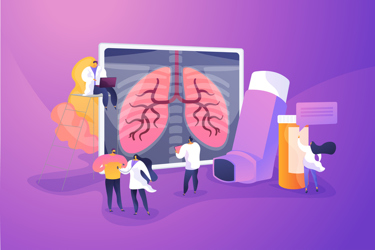The 4 Stages Of Drug Delivery Device Evolution: An Inhaler Case Study
By Valerie Phillips, Michael Noble, and Mark Humphries, PA Consulting

Hospitals without patients? Consultations via chatbots? Treatment self-administered by patients? Clinicians remotely monitoring patients from a central location? There is no doubt that the world of healthcare is undergoing a rapid transformation driven by three key factors: advances in technology, pressure on budgets, and a desire to improve patient health outcomes and experiences. This is happening across the healthcare continuum, with a move to prevention rather than treatment, a push for earlier diagnoses, care delivered at home, and a rise in personalized targeted treatments.
These macro trends in the healthcare sector are also playing out in the drug delivery device market, where we see a trend toward digitization to support wellness, education, and adherence. The aim is to ensure that patients receive the best treatment experience — therapeutically efficacious for their particular combination of personal and disease characteristics — administered in a way that complements, rather than conflicts with, their lifestyle. From a healthcare system perspective, digitization reinforces user adherence and allows for demonstrable results.
Client experience tells us that this evolution is happening in four key stages. To illustrate how device development is evolving in practice, we will use the example of respiratory inhalers. This is a well-established treatment modality, with mature technology solutions available, but one where we can envisage a number of future changes enabled by technology. The global respiratory inhaler market has an expected value of $43,214 million in 2025.
Stage 1: Adherence
In the first instance, there is a desire to ensure that patients are taking their medication when they should — a primary step toward adherence. In a practical sense, this can be achieved by adding an electronic module onto an existing device. This option does not require significant change to established design and manufacturing practices, although it does necessitate additional commodity electronics and connectivity through public networks to provide connection to the cloud.
A challenge with this approach is the high cost of the electronics, including the processes required to add a rigid printed circuit board, electronic components, and housings onto the device. One solution is to provide a reusable electronic module that the user transfers across multiple prescriptions (thereby spreading cost), but this can influence usability and requires the user to configure the system with each repeat prescription.
A second option is to consider lower-cost printed electronics. This has advantages in terms of cost, size and form factor, and flexibility in integration with the device. Using printed electronics placed in labels is a lower-cost means of achieving the same functionality, and adding a Bluetooth-connected smart label creates a connected inhaler. The primary benefit is that there is no change to the device itself, but there is the option to add a label depending on the drug and patient population. Over time, the approach can evolve so that devices become redesigned and manufacturing processes altered to integrate the desired functionality into the body of the drug delivery devices.
A third option is to remove electronics completely. One recent development uses cell phones to “listen” to the acoustic signals from an inhalation device. The phone becomes the platform for sensing, processing, and communication. By detecting characteristic signatures from devices and extracting specific characteristics from background noise, adherence can be monitored without the addition of any electronics to the device itself.
Stage 2: Behavior Change
The next stage is to influence users’ behavior and encourage optimal use of the drug delivery device. Building on the example above, we may consider using the acoustic signature to provide feedback to the user. This can provide a teaching platform for the user, to train and encourage adoption of the appropriate breathing technique during use. Through gamification, the required user steps can be encouraged, and training can be refreshed periodically to ensure the patient is using the device correctly, leading to increased efficacy and, hence, better patient outcomes. While technically challenging, deep learning algorithms can enable accurate sound interpretation, taking advantage of the vast amount of information contained within the acoustic signals.
Stage 3: Efficacy
The next step in the digital evolution of drug delivery devices is to leverage a broad range of sensors to collect and interpret data. Such sensors may be integrated into the drug delivery devices themselves, or they could be from a range of peripheral devices. The former has the advantage of direct coupling to the patient during use and can collect information on how the device is being used (e.g., typical/peak flow rates), allowing baselining and change monitoring of individual patients.
Increasingly, there is interest in integrating information from peripheral devices, where a number of measurements can be extracted from consumer electronic devices and used as further input to an overall diagnostic. This has led to an increased interest in digital biomarkers and how they can be used as diagnostic tools. One challenge here is the fidelity of the information provided by these devices, which have not typically been developed as medical devices. Such systems are currently being developed so that a medical grade measurement can be derived and used. With such data sets, there is also considerable interest in what learning can be extracted and how that might prove a useful diagnostic for both the efficacy of treatment and as a predictive tool for exacerbations. This links strongly into the payment system, as payers are increasingly demanding means of measuring demonstrable outcomes. Efficacious measurements are now the currency of value.
Stage 4: Personalization
A range of digital personalization approaches are being explored by device manufacturers, including features such as biometrically enabled lockout or personal profile selection, all the way through to adding diagnostic capability to the system. With the former, patients can ensure the device is used only by them, or specific profile settings can be called up. When diagnostic capability is added, manufacturers and/or payers can measure the impact of the drug on the patient and use this information for drug titration or re-prescribing drugs where many treatments are available. This may have different efficacy profiles with different patient populations. Diagnostic capability can be achieved via on-device sensors or by adding an additional step using a more invasive step at point of delivery to measure a range of biological markers. For this option, the driver is low-cost, minimally invasive solutions.
A recently granted patent considers a novel point of dispensing diagnostic technology that could potentially be used as a titration aid by determining the specific drug binding capacity of a person’s blood. This technology is based on the well-established, low-cost blood glucose monitoring technology.
Conclusion
Using the example of inhalers, we can see how connected drug delivery devices are evolving from promoting adherence to changing user behavior and delivering personalized treatments and efficacious outcomes. However, the biggest challenge for connected drug delivery devices remains the connection of data across the continuum of care. Traditionally, patient data resides in disparate silos, and it is typically not annotated or curated and often does not capture the full clinical context. As the number of devices and data sources proliferates, there is a growing need for a system of engagement to connect and interpret patient data from various sources to support caregivers with relevant insights at the point of care. And a future evolution of devices will undoubtedly be to address the sustainability agenda, especially when electronics are incorporated into devices, complicating the post-use disposal process.
About The Authors:
 Valerie Phillips is a medtech expert at PA Consulting. She is a market access specialist and advises on commercializing innovative medtech technologies and solutions. She has a particular interest in supporting medtech companies to develop outcomes-based customer solutions to enable providers and payers to offer value-based care. Connect with her on LinkedIn.
Valerie Phillips is a medtech expert at PA Consulting. She is a market access specialist and advises on commercializing innovative medtech technologies and solutions. She has a particular interest in supporting medtech companies to develop outcomes-based customer solutions to enable providers and payers to offer value-based care. Connect with her on LinkedIn.
 Michael Noble is a product design and engineering expert at PA Consulting. He is focused on drug delivery and diagnostic technologies, both in terms of developing the technology and IP, and creating strategies for medtech intensive organizations. Connect with him on LinkedIn.
Michael Noble is a product design and engineering expert at PA Consulting. He is focused on drug delivery and diagnostic technologies, both in terms of developing the technology and IP, and creating strategies for medtech intensive organizations. Connect with him on LinkedIn.
 Mark Humphries is a product design and engineering expert at PA Consulting. He is involved in designing and developing new medical devices, covering diagnostics and drug delivery technologies. He is particularly interested in applying new and emerging technologies to improve the functionality and usability of devices for improved outcomes. Connect with him on LinkedIn.
Mark Humphries is a product design and engineering expert at PA Consulting. He is involved in designing and developing new medical devices, covering diagnostics and drug delivery technologies. He is particularly interested in applying new and emerging technologies to improve the functionality and usability of devices for improved outcomes. Connect with him on LinkedIn.
